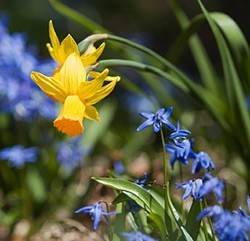So what do you do for bulb care after flowering? The bulb plants’ leaves are gradually going to turn yellow and die away. So should you braid the leaves or tie them with rubber bands to tidy your garden?
Definitely not: first, you don’t need the extra work, but second, and most important, you need to leave bulb foliage in place so the plant can “recharge” itself for next spring’s flowers.
Yes, this takes restraint because floppy tulip leaves and long-lasting daffodil leaves can look awful for awhile.
Bulb care after blooming is finished

Daffodils with scilla
The leaves perform an essential function: they use the sun’s energy to transform basic elements such as oxygen, nitrogen, phosphorous and potassium into food.
As bulb maven and garden writer Judy Glattstein, likes to say, “It is absolutely prohibited to cut, fold, braid, spindle or rubber-band bulb foliage.”
So here’s what to do:
After the bulb flowers have faded, deadhead the plants by removing faded blooms so that they won’t waste energy producing seeds. Bulbs that you are naturalizing don’t need this treatment – keep the flower heads on to encourage self-seeding.
Once bulb leaves yellow and wither, which takes about six weeks – cut them off. Planting bulbs between perennials helps to camouflage ripening foliage. Forget-me-nots, peonies, hostas and daylilies do a particularly good job of this.
However, if you can’t resist mass-planting hybrid tulips and hate their messy leaves, consider treating these bulbs as annuals, and simply pull them out after flowering to make way for summer’s flower display, as most parks departments do.
Since many hybrid tulips only look their very best the first couple of springs, this is a sure-fire way to have a terrific display – and to try out new varieties each year. (It may seem extravagant, but don’t most gardeners spring for new annuals every year?)
More Bulb Information
Unusual
bulbs that should be better known
Discover snowdrops – the earliest bulbs of spring




